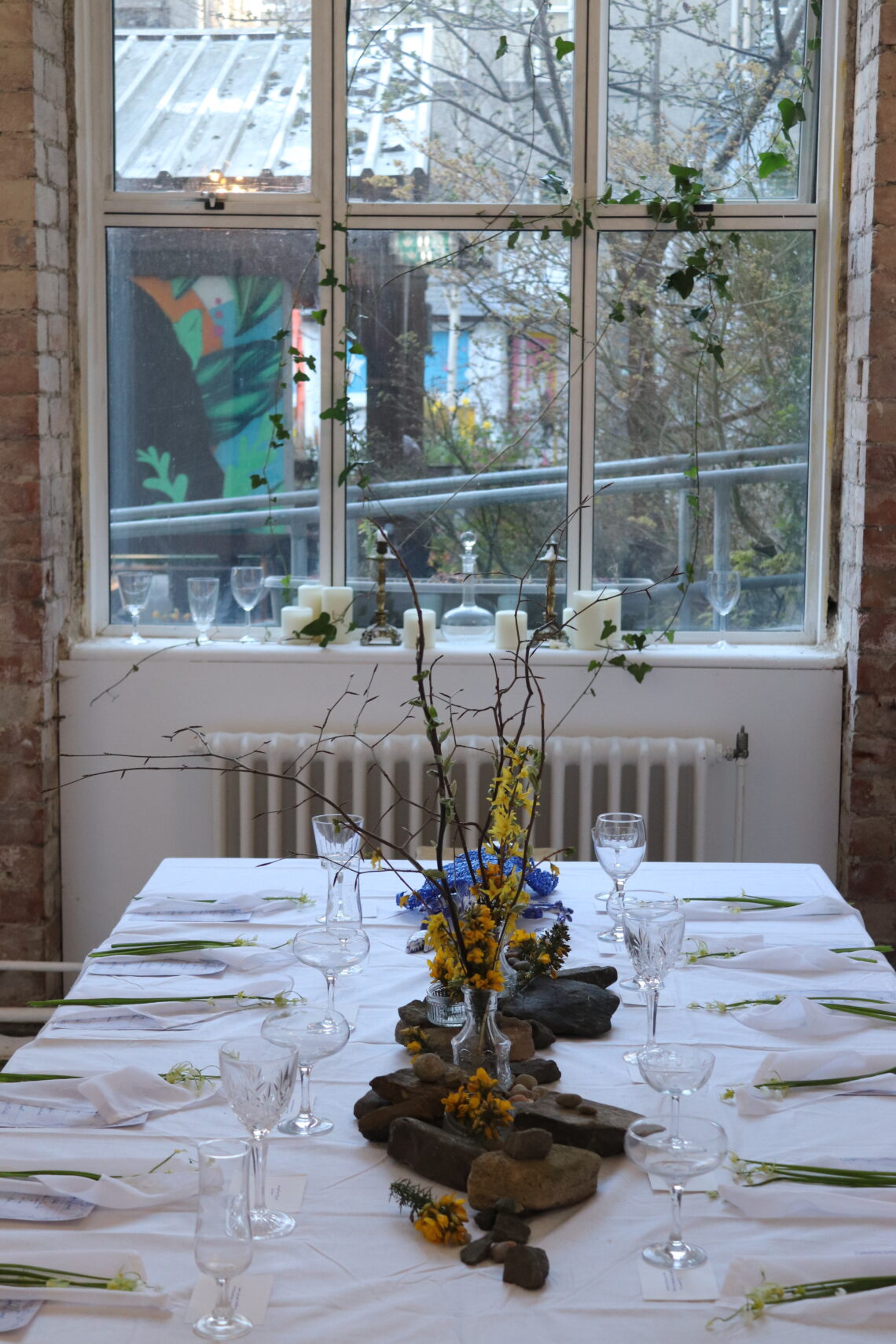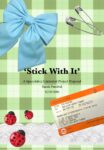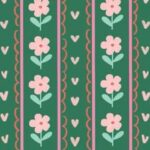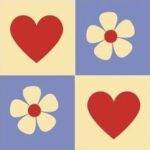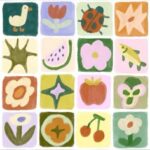Our curated event ‘Gurrl Dinner’ took place on the 6th April, building upon numerous planning meetings between myself, Kate Garramone, Emily Geary and Harry Mayston. Despite the short time scale and subsequent accelerated pace at which we need organise the evening, on the day we felt reasonably prepared for the event (please see previous posts for what did in our meetings).
The Invitations
Between the previous meeting and the event myself and Harry created a digital invitation to post to people, as well as a physical ‘menu’ that would be provided on the night. Although we had the intentions to have these ready to be posted out ahead of time, due to the short time scale of the project and a change in academic timetable resulting in us not being sure where attendees would be, made it so a digital invite would be more appropriate. We didn’t want people to miss out just because we didn’t physically see them. Based on the idea of ink, manuscripts and hand-written letters (see previous meeting’s post), we chose to create an abstract watercolour background based on the motion of petals, connecting back to nature. On top of this digitally we then wrote out our menus, illustrating the page in a way that looked like a Victorian letter. For the invitation version, we also included the venue and timings, 6.30-8 pm making the event more accessible to our audience of other students who mostly have jobs during the day. We invited 15 peers, not including San who we also encouraged to bring guests along since it was their performance. We wanted to make them as comfortable as the artist as possible.
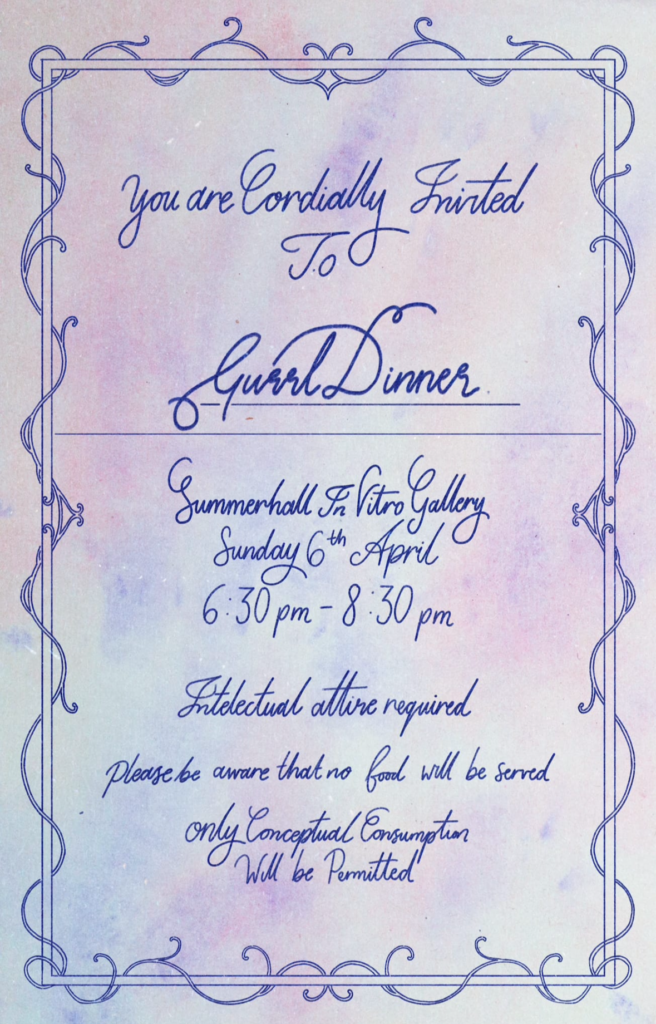
The Room
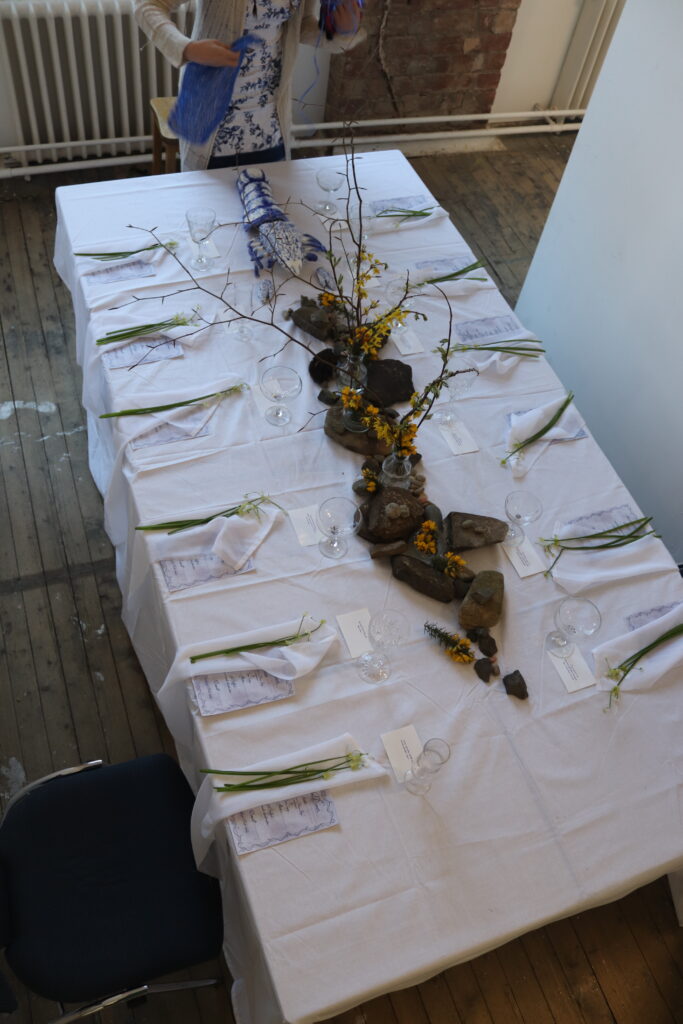 For the tablescape and overall dressing of the room, Katie took charge using the creative vision from our mood board and translating this into the In Vitro gallery. Foraging for stones, fallen vines and moss, as well as wildflowers at the Pentlands Reservoir, all of which were returned after our event to minimise our environmental impact and interference, Katie layered flora throughout the walls and the table to make a setting bringing the outside in. Vines were placed coming from windows, overlapping papers and wrapping around the table, with San’s lobster on one end. Each member of our curatorial team brought along thrifted glassware, again reducing our impact by shopping second hand and supporting local charities. These acted as anchor points for the table, allowing light to shine through and for the rocks to be uninterrupted. Onto each place setting we added a handwritten line of poetry, all of which came from feminist author bell hooks to support the construction of this event celebrating a typically gendered action – the dinner party. After testing out varying sizes and compositions for the poetry, we settled on small lowercase writing in the centre of a business card size, allowing for people to take them as they took their drink.
For the tablescape and overall dressing of the room, Katie took charge using the creative vision from our mood board and translating this into the In Vitro gallery. Foraging for stones, fallen vines and moss, as well as wildflowers at the Pentlands Reservoir, all of which were returned after our event to minimise our environmental impact and interference, Katie layered flora throughout the walls and the table to make a setting bringing the outside in. Vines were placed coming from windows, overlapping papers and wrapping around the table, with San’s lobster on one end. Each member of our curatorial team brought along thrifted glassware, again reducing our impact by shopping second hand and supporting local charities. These acted as anchor points for the table, allowing light to shine through and for the rocks to be uninterrupted. Onto each place setting we added a handwritten line of poetry, all of which came from feminist author bell hooks to support the construction of this event celebrating a typically gendered action – the dinner party. After testing out varying sizes and compositions for the poetry, we settled on small lowercase writing in the centre of a business card size, allowing for people to take them as they took their drink.
After testing Emily’s idea of having one chair per place setting we realised that this made the table difficult to interact with, and didn’t provide San as the performer much space. We did however think that chairs were necessary, and so compromised by having two semi-circles of chairs arching around the bottom end similar to an amphitheatre. This further set the table as an installation piece.
Finally we set up the interactive area for the main course to the left of the room as you entered. We taped up large sheets of paper on the walls and placed charcoal and oil pastels in two platters on plinths, as if they were ingredients or something to eat from. The dishes were blue and white to match San’s lobster and the writing on the poetry notes, making the room more cohesive. By the door we placed the menus, giving us a space to greet guests as they arrived and serving them flavoured water from the table.
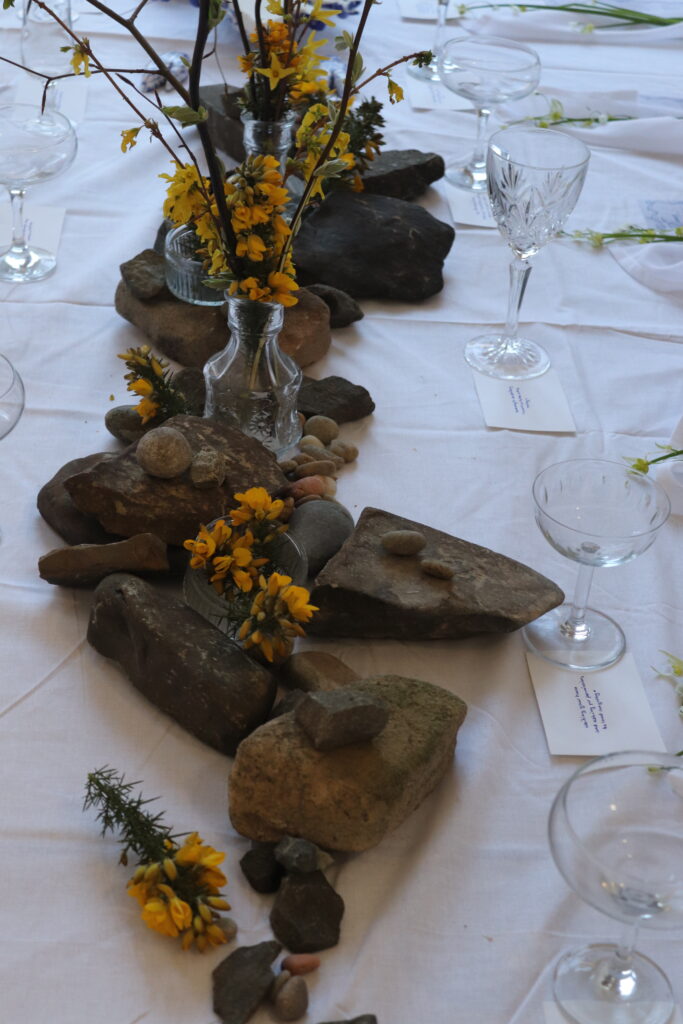
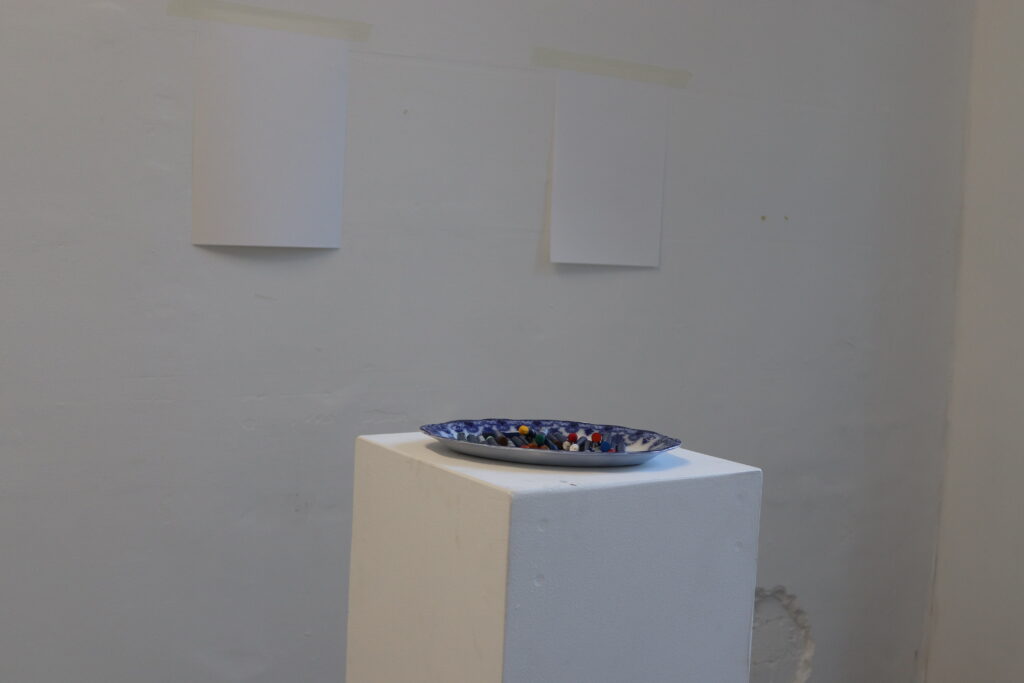
The Main Event
With guests arriving we gave everyone time to greet each other and explore the room, taking in the table, the lobster and the various set ups. In total we had 15 people attend the event, ourselves and the artist included. After 15 minutes we encouraged everyone to take their seats and Katie gave an opening speech, welcoming guests to the dinner and thanking them for dining with us that evening. From there San did their performance of ‘Lobster in a China Shop’ which worked as a great focus for the evening. Because of the intimacy of the venue and our set up the performance really felt as if they were talking directly to the guests. From there after applause I thanked San and introduced the main course. I explained for people to take one material and allow themselves to freely respond to the performance on the papers, ‘digesting’ what they had seen and literally building the components of the meal for others to see. This lasted for half an hour, with people working collaboratively and combining language with imagery in their interpretations. From there we then finally returned back to the performance space for the Fruit Salad, taking turns to read out loud the poems. The final selection was: The Orange by Wendy Cope (1992), Blackberry Picking by Seamus Heaney (1966), The Plum You’re Going to Eat Next Summer by Gayle Brandeis (2024), and Goblin Market by Christina Rossetti (1862). After this, a final thanks took place, and people were encouraged to stay and chat like after an actual dinner party.
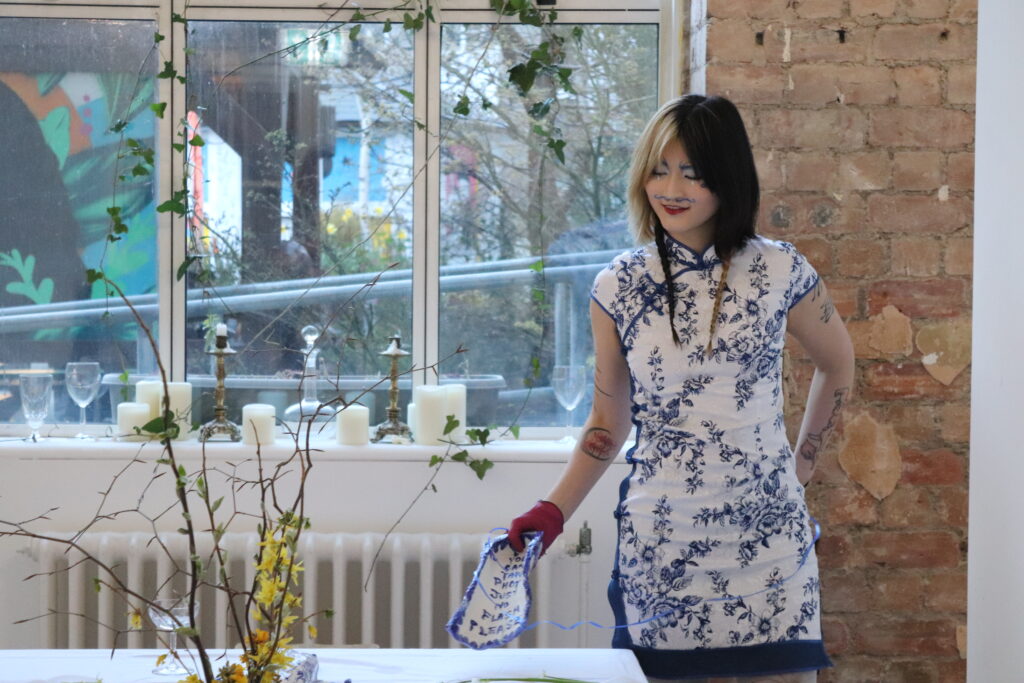
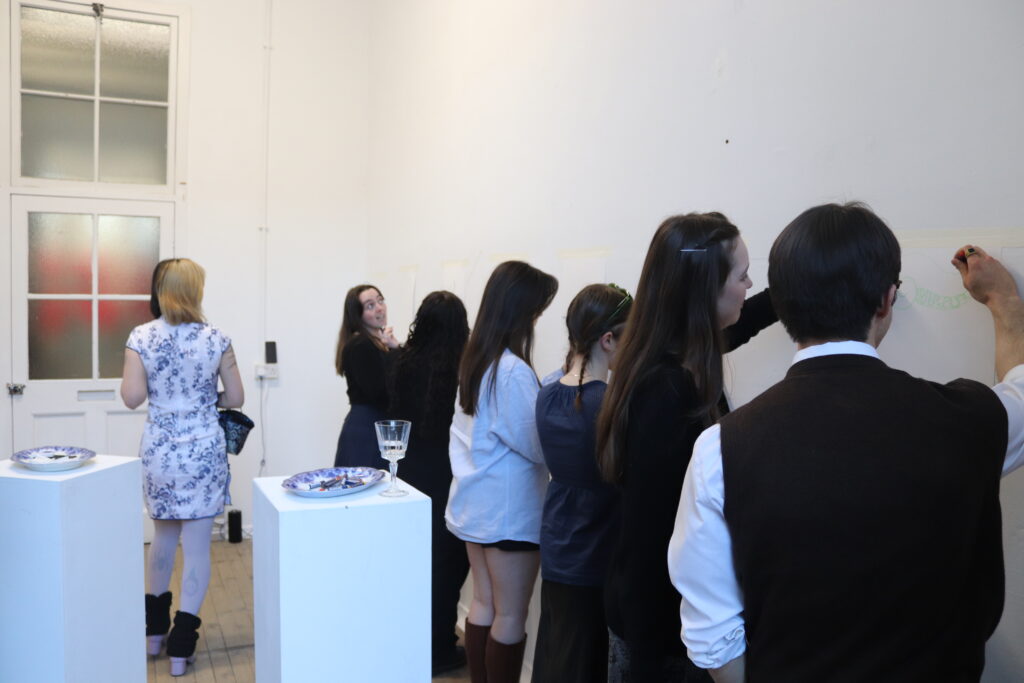
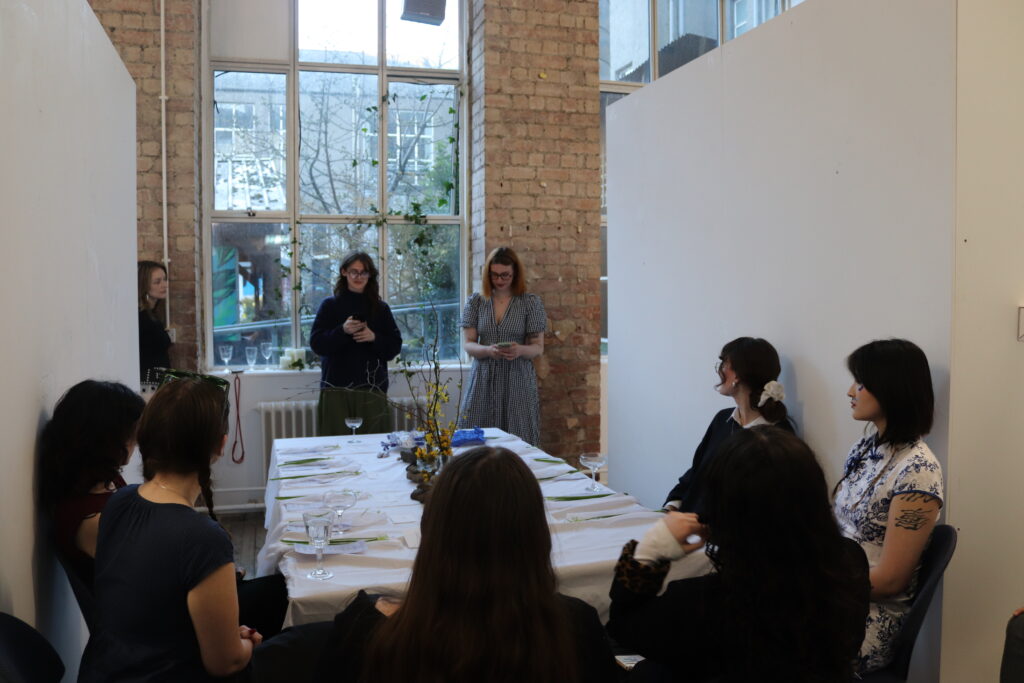
Feedback and Learning
Overall the dinner went very well, with people fully engaging and visibly enjoying themselves throughout the night. I think that the central reflective drawing task was an excellent way to have people respond to San’s performance beyond just having a conversation about it, and we did well to tailor this task to the intended audience, pairing the activity to people who would get stuck in with it and wholeheartedly take part. This is something that I really need to bear in mind with my project, understanding the way that participants would take part. If we had more time to plan the event, I think there are a few things we as a group would like to change such as printing out the poems and offering them as handouts for improved accessibility, since they were only audibly said off our phone screens. I also think that we would perhaps change the chairs to include coverings, something we did discuss but decided that it wasn’t in our budget. Although this was only a small event, it has shown me a great complete process of both running a workshop and hosting an event, allowing me to approach my project and relative public programmed artist talks in a more realistic and practical way. I know that my workshops will not need as much room dressing as this dinner but I want to rethink how long I should book my venue for, accommodating the length of preparatory time. This experience also gave me knowledge as to how to realistically work with an artist and maintain a good working relationship with them, something I can translate onto my artist talks.
All Photos are taken by Harry Mayston and Kate Garramone (2025)
